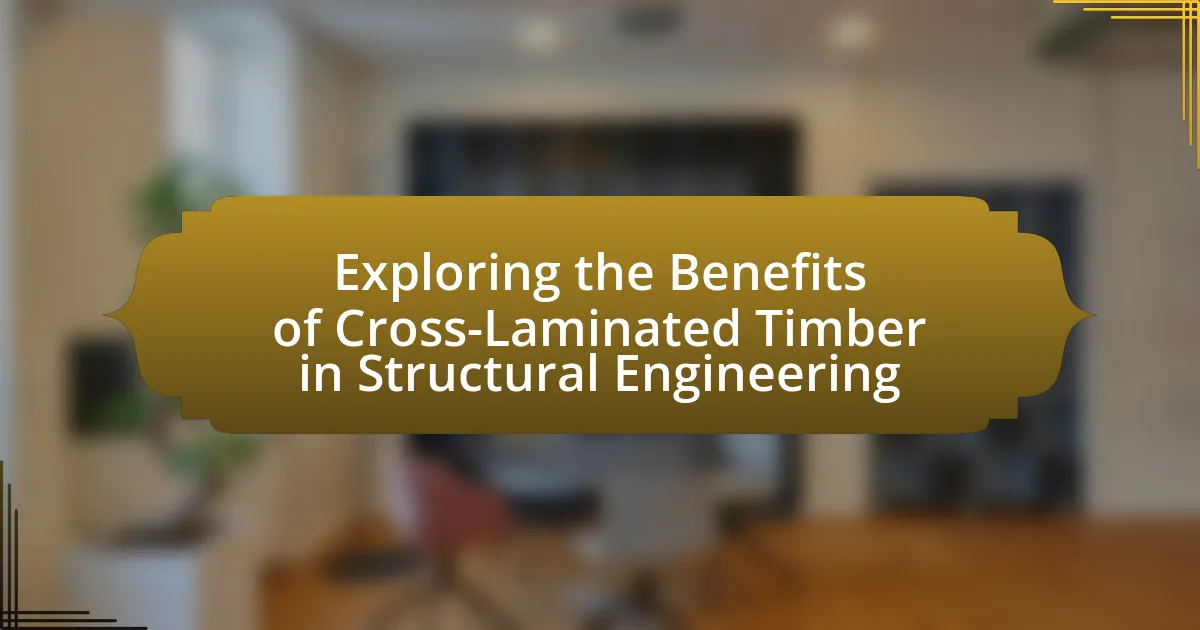Cross-Laminated Timber (CLT) is an engineered wood product that consists of layers of lumber boards stacked crosswise and glued together, providing enhanced structural strength and stability. This article explores the role of CLT in structural engineering, highlighting its advantages over traditional materials such as concrete and steel, including sustainability, reduced weight, improved thermal performance, and faster construction times. Key topics include the manufacturing process of CLT, its unique properties, environmental benefits, and the challenges associated with its use. Additionally, the article discusses the cost advantages, design flexibility, and future trends in CLT applications, emphasizing its growing popularity in modern construction practices.

What is Cross-Laminated Timber and its Role in Structural Engineering?
Cross-Laminated Timber (CLT) is an engineered wood product made from layers of lumber boards stacked crosswise and glued together, providing enhanced structural strength and stability. In structural engineering, CLT serves as a sustainable alternative to traditional building materials like concrete and steel, offering benefits such as reduced weight, improved thermal performance, and faster construction times. Studies indicate that CLT can achieve comparable load-bearing capacities to concrete, making it suitable for multi-story buildings and large-span structures. Additionally, the use of CLT contributes to lower carbon emissions, as it sequesters carbon dioxide during its lifecycle, aligning with modern sustainability goals in construction.
How is Cross-Laminated Timber manufactured?
Cross-Laminated Timber (CLT) is manufactured by stacking layers of lumber boards in alternating directions and bonding them together with adhesive. This process typically involves three to seven layers of wood, which are glued under pressure to create large, solid panels. The cross-lamination technique enhances the structural integrity and dimensional stability of the timber, making it suitable for various construction applications. The use of high-quality adhesives and precise manufacturing techniques ensures that the panels meet stringent performance standards, contributing to their growing popularity in sustainable building practices.
What are the key materials used in Cross-Laminated Timber production?
The key materials used in Cross-Laminated Timber (CLT) production are primarily softwood species, such as spruce, pine, and fir. These wood types are selected for their strength, availability, and favorable properties for lamination. In CLT production, layers of these wood boards are glued together at perpendicular angles, enhancing structural integrity and stability. The adhesive used in this process is typically a structural-grade polyurethane or phenol-formaldehyde, which ensures durability and moisture resistance. This combination of softwood and high-performance adhesives is essential for creating the engineered wood product known for its strength and versatility in construction.
What processes are involved in the layering of Cross-Laminated Timber?
The processes involved in the layering of Cross-Laminated Timber (CLT) include the selection of lumber, drying, gluing, pressing, and finishing. Initially, high-quality timber is selected and dried to a specific moisture content to prevent warping. The dried lumber is then glued together in layers, typically with each layer oriented perpendicular to the adjacent one, enhancing structural stability. After applying adhesive, the layers are pressed together under controlled conditions to ensure a strong bond. Finally, the CLT panels are finished to meet design specifications and quality standards. This systematic approach results in a durable and efficient building material, as evidenced by its widespread use in modern construction projects.
What are the unique properties of Cross-Laminated Timber?
Cross-Laminated Timber (CLT) possesses unique properties such as high strength-to-weight ratio, dimensional stability, and excellent fire resistance. The high strength-to-weight ratio allows CLT to support significant loads while remaining lightweight, making it suitable for multi-story buildings. Dimensional stability is achieved through the cross-lamination process, which reduces the risk of warping and shrinkage, ensuring consistent performance over time. Additionally, CLT’s fire resistance is enhanced by its mass, which allows it to char on the surface while maintaining structural integrity, a property supported by studies indicating that CLT can withstand fire exposure effectively.
How does Cross-Laminated Timber compare to traditional building materials?
Cross-Laminated Timber (CLT) offers several advantages over traditional building materials such as concrete and steel. CLT is lighter than concrete and steel, which reduces the overall structural load and can lead to lower foundation costs. Additionally, CLT has superior thermal insulation properties, resulting in better energy efficiency for buildings. Studies indicate that CLT can sequester carbon, making it a more sustainable option compared to traditional materials that typically have higher carbon footprints. For instance, a study published in the Journal of Cleaner Production found that using CLT can reduce greenhouse gas emissions by up to 75% compared to concrete. Furthermore, CLT allows for faster construction times due to its prefabricated nature, which can significantly decrease labor costs and project timelines.
What structural advantages does Cross-Laminated Timber provide?
Cross-Laminated Timber (CLT) provides significant structural advantages, including high strength-to-weight ratio, dimensional stability, and excellent seismic performance. The high strength-to-weight ratio allows CLT to support substantial loads while being lighter than traditional materials like concrete and steel, making it easier to transport and handle. Dimensional stability is achieved through the cross-lamination process, which minimizes warping and shrinkage, ensuring consistent performance over time. Additionally, CLT’s excellent seismic performance is attributed to its ability to absorb and dissipate energy during earthquakes, enhancing the safety of structures built with this material. These advantages are supported by research indicating that CLT structures can outperform conventional materials in various structural applications.
Why is Cross-Laminated Timber gaining popularity in modern construction?
Cross-Laminated Timber (CLT) is gaining popularity in modern construction due to its sustainability, strength, and efficiency. As a renewable resource, CLT significantly reduces carbon emissions compared to traditional materials like concrete and steel, aligning with global sustainability goals. Additionally, CLT’s engineered wood structure provides high strength-to-weight ratios, allowing for taller and lighter buildings. Studies indicate that CLT can reduce construction time by up to 25% due to its prefabricated nature, which streamlines the building process. These factors collectively contribute to the increasing adoption of CLT in contemporary architectural practices.
What environmental benefits does Cross-Laminated Timber offer?
Cross-Laminated Timber (CLT) offers significant environmental benefits, primarily through carbon sequestration and reduced greenhouse gas emissions. CLT is made from sustainably sourced wood, which captures carbon dioxide during its growth, effectively storing carbon in the built environment. According to a study by the University of Washington, using CLT can result in a 20-30% reduction in carbon emissions compared to traditional concrete and steel construction methods. Additionally, CLT production typically requires less energy, further decreasing its overall environmental impact. The use of CLT also promotes sustainable forestry practices, as it encourages the use of renewable resources and reduces reliance on non-renewable materials.
How does Cross-Laminated Timber contribute to sustainable building practices?
Cross-Laminated Timber (CLT) contributes to sustainable building practices by utilizing renewable wood resources, which sequester carbon dioxide during their growth. This process reduces greenhouse gas emissions compared to traditional building materials like concrete and steel, which are energy-intensive to produce. Additionally, CLT can be sourced from sustainably managed forests, ensuring that timber harvesting does not lead to deforestation. Studies indicate that using CLT can result in a 20-30% reduction in the carbon footprint of a building compared to conventional materials. Furthermore, CLT’s prefabrication allows for efficient construction processes, minimizing waste and energy consumption on-site.

What are the specific benefits of using Cross-Laminated Timber in structural engineering?
Cross-Laminated Timber (CLT) offers several specific benefits in structural engineering, including sustainability, strength, and design flexibility. CLT is made from layers of wood glued together at right angles, which enhances its structural integrity and load-bearing capacity, making it suitable for tall buildings. Additionally, CLT is a renewable resource, contributing to reduced carbon emissions compared to traditional materials like concrete and steel. Studies indicate that using CLT can lower the overall environmental impact of construction projects, as it sequesters carbon throughout its lifecycle. Furthermore, the prefabrication of CLT panels allows for faster construction times and reduced waste on-site, improving efficiency in the building process.
How does Cross-Laminated Timber enhance design flexibility?
Cross-Laminated Timber (CLT) enhances design flexibility by allowing architects and engineers to create complex shapes and structures that traditional materials cannot easily accommodate. The layered construction of CLT provides high strength-to-weight ratios, enabling longer spans and open floor plans without the need for extensive support columns. Additionally, CLT can be prefabricated into various forms, which streamlines the construction process and allows for customization in design. This adaptability is supported by studies showing that CLT can be used in a wide range of applications, from residential buildings to large commercial projects, thus proving its versatility in modern architectural design.
What architectural styles can benefit from Cross-Laminated Timber?
Cross-Laminated Timber (CLT) can benefit various architectural styles, particularly modern, contemporary, and sustainable designs. These styles often emphasize open spaces, natural materials, and eco-friendly construction methods, which align well with the properties of CLT, such as its strength, lightweight nature, and aesthetic appeal. For instance, modern architecture frequently utilizes large spans and minimalistic designs, where CLT can provide structural integrity while maintaining visual simplicity. Additionally, sustainable architecture prioritizes renewable materials, and CLT, being made from sustainably sourced timber, supports this goal. Studies have shown that CLT can reduce carbon footprints in construction, making it an ideal choice for environmentally conscious architectural practices.
How does Cross-Laminated Timber facilitate innovative construction techniques?
Cross-Laminated Timber (CLT) facilitates innovative construction techniques by enabling faster assembly and reducing the need for heavy machinery. The prefabrication of CLT panels allows for precise manufacturing off-site, which streamlines the construction process and minimizes on-site labor. Studies indicate that projects utilizing CLT can be completed up to 25% faster than traditional methods, as reported by the University of Massachusetts Amherst in their research on the efficiency of CLT in construction. This efficiency not only accelerates project timelines but also enhances design flexibility, allowing architects to create complex structures with less material waste.
What cost advantages does Cross-Laminated Timber provide?
Cross-Laminated Timber (CLT) provides significant cost advantages primarily through reduced construction time and labor expenses. The prefabrication of CLT panels allows for quicker assembly on-site, which can decrease overall project timelines by up to 25% compared to traditional building methods. This efficiency translates to lower labor costs, as fewer workers are needed for a shorter duration. Additionally, CLT’s lightweight nature reduces transportation costs and simplifies foundation requirements, further contributing to overall savings. Studies have shown that projects utilizing CLT can achieve cost reductions of 10-15% in total construction expenses, making it a financially attractive option in structural engineering.
How does the use of Cross-Laminated Timber impact overall project costs?
The use of Cross-Laminated Timber (CLT) can significantly reduce overall project costs. This reduction is primarily due to its lightweight nature, which decreases transportation and foundation costs, and its prefabrication capabilities, which shorten construction time and labor expenses. Studies indicate that projects utilizing CLT can achieve up to a 20% reduction in construction time compared to traditional materials, leading to lower labor costs and faster project delivery. Additionally, the thermal efficiency of CLT can result in reduced energy costs during the building’s lifecycle, further contributing to overall savings.
What are the long-term savings associated with Cross-Laminated Timber structures?
Long-term savings associated with Cross-Laminated Timber (CLT) structures primarily stem from reduced construction costs, lower energy expenses, and decreased maintenance requirements. CLT’s prefabrication allows for faster assembly, which can cut labor costs by up to 20% compared to traditional building methods. Additionally, CLT structures offer superior thermal insulation, leading to energy savings of approximately 10-30% over the lifespan of the building. Furthermore, the durability of CLT reduces the frequency and cost of maintenance, contributing to overall savings. These factors collectively enhance the economic viability of CLT in structural engineering projects.
How does Cross-Laminated Timber improve construction efficiency?
Cross-Laminated Timber (CLT) improves construction efficiency by enabling faster assembly and reducing labor costs. The prefabrication of CLT panels allows for quicker on-site installation, as these panels are manufactured to precise specifications in a controlled environment. This process minimizes waste and ensures high quality, leading to a reduction in the overall construction timeline. Studies indicate that projects utilizing CLT can be completed up to 25% faster compared to traditional building methods, which directly correlates to lower labor expenses and enhanced project management efficiency.
What role does prefabrication play in the efficiency of Cross-Laminated Timber?
Prefabrication significantly enhances the efficiency of Cross-Laminated Timber (CLT) by streamlining the construction process and reducing on-site labor. This method allows for the manufacturing of CLT panels in controlled factory settings, which ensures precision and quality control, leading to faster assembly times on-site. Studies indicate that prefabricated CLT components can reduce construction time by up to 25% compared to traditional building methods, as they are ready to be installed upon arrival. Additionally, prefabrication minimizes waste and improves material utilization, contributing to overall sustainability in construction practices.
How does Cross-Laminated Timber reduce construction time?
Cross-Laminated Timber (CLT) reduces construction time by enabling faster assembly through prefabrication. CLT panels are manufactured off-site, allowing for quick installation on-site, which significantly shortens the overall construction schedule. Studies indicate that projects utilizing CLT can be completed up to 25% faster compared to traditional building methods, as the panels are ready to be erected upon arrival, minimizing delays associated with on-site construction activities.

What challenges and considerations are associated with Cross-Laminated Timber?
Cross-Laminated Timber (CLT) faces several challenges and considerations, including moisture sensitivity, fire resistance, and structural performance. Moisture can lead to dimensional changes and potential degradation, necessitating careful design and construction practices to mitigate water exposure. Fire resistance is another concern, as CLT requires specific treatments or design strategies to meet building codes, particularly in taller structures. Additionally, structural performance must be evaluated, as the mechanical properties of CLT can vary based on the wood species and manufacturing process, impacting load-bearing capacity and overall stability. These challenges highlight the need for thorough planning and adherence to standards in CLT applications.
What are the potential drawbacks of using Cross-Laminated Timber?
The potential drawbacks of using Cross-Laminated Timber (CLT) include susceptibility to moisture, limited fire resistance, and higher initial costs compared to traditional materials. Moisture can lead to swelling, warping, or decay, which compromises structural integrity; studies indicate that wood products can absorb moisture, affecting performance. Fire resistance is another concern, as CLT may not meet the same fire safety standards as concrete or steel, necessitating additional fireproofing measures. Additionally, the initial costs of CLT can be higher due to manufacturing and sourcing, which may deter some projects despite long-term savings in energy efficiency and construction speed.
How does moisture affect the performance of Cross-Laminated Timber?
Moisture significantly affects the performance of Cross-Laminated Timber (CLT) by influencing its dimensional stability, strength, and durability. High moisture content can lead to swelling, warping, and potential structural failure, while low moisture levels can cause shrinkage and cracking. Research indicates that CLT’s performance is optimal when maintained within a moisture content range of 8% to 12%, as deviations from this range can compromise its mechanical properties and longevity. For instance, studies have shown that excessive moisture can reduce the bending strength of CLT by up to 30%, highlighting the critical need for moisture management in its application.
What are the fire safety considerations for Cross-Laminated Timber structures?
Fire safety considerations for Cross-Laminated Timber (CLT) structures include the material’s inherent fire resistance, the design of fire-rated assemblies, and compliance with building codes. CLT exhibits a charring rate of approximately 0.6 mm per minute, which allows it to maintain structural integrity longer than many other materials during a fire. Additionally, proper design can incorporate fire-resistant coatings and barriers to enhance safety. Building codes, such as the International Building Code, provide guidelines for the use of CLT in various occupancy types, ensuring that fire safety measures are adequately addressed.
How can engineers effectively integrate Cross-Laminated Timber into their projects?
Engineers can effectively integrate Cross-Laminated Timber (CLT) into their projects by utilizing its structural properties and sustainability benefits in design and construction. CLT’s high strength-to-weight ratio allows for innovative architectural designs while reducing the overall carbon footprint of buildings. For instance, studies have shown that using CLT can decrease greenhouse gas emissions by up to 75% compared to traditional materials like concrete and steel. Additionally, engineers should collaborate with architects early in the design process to optimize the use of CLT, ensuring that its unique characteristics are fully leveraged for load-bearing and aesthetic purposes. This collaborative approach, combined with adherence to building codes and standards specific to CLT, facilitates successful integration into various structural applications.
What design guidelines should be followed when using Cross-Laminated Timber?
When using Cross-Laminated Timber (CLT), designers should adhere to guidelines that ensure structural integrity, sustainability, and compliance with building codes. These guidelines include considering the load-bearing capacity of CLT panels, ensuring proper moisture control to prevent degradation, and incorporating fire safety measures, as CLT has specific fire resistance ratings that must be met. Additionally, designers should account for the thermal and acoustic performance of CLT, as well as its environmental impact, by sourcing timber from sustainably managed forests. The National Design Specification for Wood Construction provides detailed standards and recommendations for the design and use of CLT, reinforcing the importance of following established guidelines to achieve optimal performance and safety in structural applications.
What best practices should be considered for the maintenance of Cross-Laminated Timber structures?
Best practices for the maintenance of Cross-Laminated Timber (CLT) structures include regular inspections, moisture control, and protective coatings. Regular inspections should focus on identifying signs of damage, such as cracks or insect infestations, which can compromise structural integrity. Moisture control is crucial, as excessive moisture can lead to decay; maintaining proper ventilation and drainage systems helps mitigate this risk. Additionally, applying protective coatings can enhance durability by providing a barrier against environmental factors. These practices are supported by studies indicating that proactive maintenance significantly extends the lifespan of CLT structures and preserves their performance characteristics.
What are the future trends for Cross-Laminated Timber in structural engineering?
Future trends for Cross-Laminated Timber (CLT) in structural engineering include increased adoption due to sustainability, advancements in design technology, and enhanced building codes. The growing emphasis on reducing carbon footprints drives architects and engineers to favor CLT, as it sequesters carbon and utilizes renewable resources. Innovations in digital design tools, such as Building Information Modeling (BIM), facilitate more efficient and complex CLT structures, allowing for greater architectural creativity and precision. Additionally, evolving building codes are increasingly accommodating taller timber structures, as evidenced by the International Building Code’s updates that permit CLT in mid-rise and high-rise buildings. These trends indicate a significant shift towards integrating CLT as a mainstream material in modern construction practices.
How is technology influencing the development of Cross-Laminated Timber?
Technology is significantly influencing the development of Cross-Laminated Timber (CLT) by enhancing manufacturing processes, improving design capabilities, and increasing sustainability. Advanced computer-aided design (CAD) software allows for precise modeling and optimization of CLT structures, leading to more efficient use of materials and better performance. Additionally, innovations in adhesive technologies and automated production techniques have streamlined the manufacturing process, resulting in higher quality and more consistent products. For instance, the use of robotic systems in fabrication has reduced waste and improved accuracy, which is crucial for meeting building codes and standards. Furthermore, technology-driven research into the environmental benefits of CLT, such as its carbon sequestration properties, supports its adoption in sustainable construction practices.
What innovations are on the horizon for Cross-Laminated Timber applications?
Innovations on the horizon for Cross-Laminated Timber (CLT) applications include advancements in hybrid construction techniques, enhanced fire resistance treatments, and the integration of smart technologies. Hybrid construction techniques combine CLT with other materials, such as steel or concrete, to optimize structural performance and design flexibility. Enhanced fire resistance treatments are being developed to improve the safety of CLT in high-rise buildings, addressing concerns about combustibility. Additionally, the integration of smart technologies, such as sensors for monitoring structural health and environmental conditions, is expected to increase the functionality and longevity of CLT structures. These innovations are supported by ongoing research and development efforts in the field, demonstrating the potential for CLT to play a significant role in sustainable and resilient building practices.
What practical tips can be applied when working with Cross-Laminated Timber?
When working with Cross-Laminated Timber (CLT), it is essential to ensure proper moisture control to prevent warping and dimensional changes. This involves storing CLT panels in a dry environment and using moisture barriers during construction. Additionally, accurate cutting and machining are crucial; using sharp tools and precise measurements minimizes defects and ensures a better fit. It is also important to consider the weight of CLT, as it is significantly lighter than traditional materials, which can affect handling and transportation logistics. Furthermore, understanding the structural properties of CLT, such as its strength and stiffness, allows for optimized design and load distribution. These practices are supported by studies indicating that proper handling and installation techniques can enhance the performance and longevity of CLT structures.

Leave a Reply